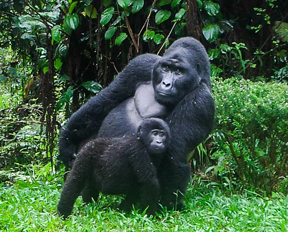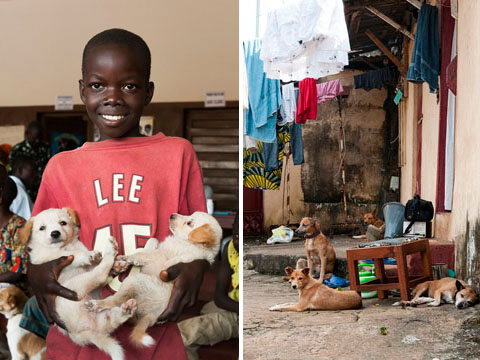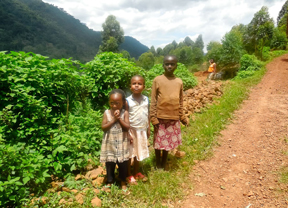
Photo by Dr. Gladys Kalema-Zikusoka
Mountain gorillas living in Uganda's Bwindi Impenetrable National Park are a strong ecotourism attraction.
Nearly half the world’s remaining 880 mountain gorillas live in Bwindi Impenetrable National Park, a jungle covering 128 square miles in southwestern Uganda. Its name notwithstanding, people enter the park regularly as visitors, tourists and workers. The gorillas, in turn, venture out to forage in nearby communities that make up one of the most densely populated parts of Africa.
The potential for contact between the two closely related species brings a shared risk: disease. With more than 98 percent of their DNA in common, mountain gorillas and humans are vulnerable to many of the same illnesses, from respiratory diseases such as tuberculosis to infections by intestinal parasites such as giardia.
What are the specific ways that disease can pass from people to mountain gorillas and the reverse? The question has captured the attention of Dr. Radford Davis, an associate professor of public health in the Department of Veterinary Microbiology and Preventive Medicine at Iowa State University’s College of Veterinary Medicine.
Davis hopes to make a trip to Uganda this fall to study the health connections between the mountain gorillas, the local people and their environment. His idea is not in the usual mode of going as a doctor-scientist, examining patients, collecting biological samples and the like. He would bring only one type of diagnostic tool: cameras. His role would be as a documentary photographer.
In a video posted online to garner financial support for the project, Davis explains:
“This photography project is going to tell the story of how the survival of the endangered mountain gorillas is tied to the health and prosperity of the people living near Bwindi Impenetrable National Park.”
Alluding to an increasingly accepted public-health concept known as One Health, Davis continues: “… this idea that the health of animals, people and our environment is connected has become widely embraced because it’s simply true. And it’s near Bwindi Impenetrable National Park that this concept of interdependent health — one health — is most obvious. Here, the health and survival of the endangered mountain gorillas is dependent upon the health of the people around them.”
In turn, the well-being of the local people is dependent on a robust gorilla population, Davis says. That’s because Bwindi and the mountain gorillas bring in about half of the country’s ecotourism dollars.
“Take away the gorillas, and poverty deepens, and health worsens,” he says. “… I hope to give voice to the local communities and catalyze change for the better.

Photos by Dr. Radford Davis
Dr. Radford Davis traveled to Sierra Leone in 2010 to document efforts to control rabies. At left, a boy in Bo cheerfully stands in line with his two puppies, awaiting their turn for rabies vaccinations.
At right, free-roaming dogs lounge outside the only veterinary clinic in the capital city of Freetown.
Davis made a similar
trip in 2010 to Sierra Leone in West Africa, sent by the United Nations Food and Agriculture Organization (FAO) to provide veterinary and public-health expertise in evaluating that country’s rabies problem. “While there, I was dubbed ‘the photographer,’ which can be very useful,” he recounted. “(The) FAO used the photos in their blogs and websites and newsletters to show people what they were doing to help. I wore two hats … vet and photographer.
“A photo can show people quickly the situation (and) the need, as well as the success stories and the real people that are being helped or need help.
"
Davis believes that his background in veterinary medicine and public health sharpens his eye for telling images. For example, he said, “How many photographers know that a biting dog needs to be quarantined for 10 days after biting a person, and know enough to ask this and photograph those who would be involved? Same can be said of drinking milk in Uganda. Is it boiled first? Why would we want it to be? What diseases could there be in that milk, and how would those impact a family? I know, but I would bet 99 percent of other photographers wouldn’t, which gives me the edge to capture an inside story and look at hidden issues.”
Davis has been a veterinarian since 1991, when he earned a DVM from Colorado State University. A master’s in public health from the University of Arizona followed in 1997.
His attention was drawn to the mountain gorillas and the human communities around Bwindi when he learned via Twitter about the work of Dr. Gladys Kalema-Zikusoka, an award-winning conservationist. Kalema-Zikusoka set up the first veterinary department in the Uganda Wildlife Authority in 1996. She was the first wildlife veterinarian in Uganda, and her primary patients were mountain gorillas.
In a pivotal case, Kalema-Zikusoka examined an infant gorilla from Bwindi that had died of scabies, a contagious skin disease caused by an infestation of the human itch mite. Kalema-Zikusoka said the mites were traced to the surrounding human communities, where the inhabitants, many impoverished, tend to have inadequate hygiene and other poor health habits.
The fatal scabies case motivated Kalema-Zikusoka, along with her husband, Lawrence Zikusoka and a veterinary technician named Steven Rubanga, to establish a nonprofit organization, Conservation Through Public Health (CTPH). Its goal is to promote biodiversity conservation by enabling people, wildlife and livestock to coexist through the prevention and control of the spread of zoonotic diseases, among other interventions.
Working with CTPH and Kalema-Zikusoka, Davis hopes to spend time with park rangers, examining their daily routines as he learns about their jobs, health and lives. He imagines a ranger going home to a wife who has an infectious disease, then returning to work in the park, bearing the pathogen. He envisions telling such a story photographically, exploring how the spouse became infected, her recovery and how the husband can be prevented from carrying sickness to the gorillas.
Considering other scenarios, Davis said: “Sometimes people will let their livestock roam into the park, and that brings parasites like cryptosporidium and giardia with them. (Or) a person with cryptosporidium … may defecate (in the park), and a gorilla comes in contact with the feces. …
“If you start getting tuberculosis or another disease, and that starts killing gorillas, now you’ve got fewer (tourist) dollars coming into Uganda and local Bwindi villages.”
The gorillas are a lucrative tourist draw. The shy primates were popularized in the 1983 book “Gorillas in the Mist” by Dian Fossey, a zoologist portrayed by the actress Sigourney Weaver in a movie by the same title. No mountain gorillas (Gorilla beringei beringei) live in zoos; they can be seen only in the wild in Africa. Observing them in Bwindi requires a permit that costs $350 or $600, depending on the time of year.
According to Kalema-Zikusoka, 11 of 30 gorilla groups in Bwindi deliberately are habituated to humans: one group for research, and the remaining 10 for tourism. The process of habituation takes two years, Kalema-Zikusoka said.
One gorilla group may comprise four to as many as 50 individuals, she said; the average size is 12.

Photo by Dr. Gladys Kalema-Zikusoka
The health and economic welfare of the people living around Bwindi is intertwined with the well-being of mountain gorillas.
A rule aimed at preventing transmission of zoonotic diseases, such as measles or tuberculosis, is to keep a distance between people and gorillas of at least 7.5 yards (seven meters), but sometimes one species or the other breaks the rule. In any case, Kalema-Zikusoka said, “You can get pretty close.”
For their part, gorillas sometimes forage in the thickly populated communities outside the park. Kalema-Zikusoka said many residents have less-than-adequate hygiene practices such as not covering rubbish heaps, defecating on the ground (children especially), and placing dirty clothing on scarecrows, making for many potential avenues for gorillas to be exposed to human pathogens.
Although Davis is working in conjunction with CTPH, the organization cannot afford to pay for his travel and work. To raise funds, Davis landed a posting on IndieVoices, a curated crowdfunding site for media projects. He is seeking $27,925 by Aug. 21.
He proposes to make photographs and audio recordings available for educational programs in local schools and other community venues. He hopes to create an electronic book, website and gallery exhibit to raise awareness internationally, as well.
His intended focus is not just the downtrodden and poor, but a panorama of life in the region — gorillas, people, health, poverty, encroachment and the striking beauty of Bwindi.
"There's a lot of happiness and hope and beauty that comes from any culture," Davis said. "I try to capture that, as well, and try to tell the whole picture. I try to generate a story about what's really happening, where's the need and what can we do to improve things."